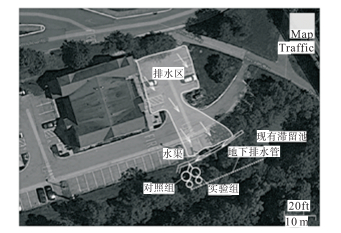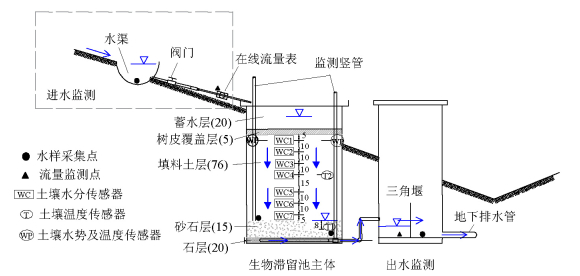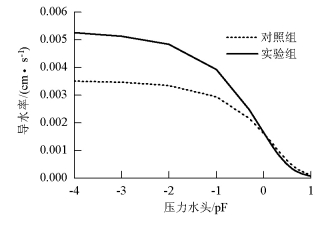Effects of Biochar on Hydrologic Performance of Bioretention
-
摘要: 为了研究生物炭的添加对生物滞留池雨水下渗、持水能力及水力停留时间的影响,在一野外中试生物滞留池中加入了4%(w/w)的生物炭,对该生物滞留池进行了导水率测试和3次溴示踪模拟降雨实验.研究结果表明:与无生物炭的对照组相比,生物炭的施用将填料土的饱和导水率增大了1.5倍;生物滞留池的水力停留时间延长了近1 h;渗流区的体积含水量增加了11%~23%;施用生物炭可全面提高生物滞留池的水力表现,避免溢流,削减洪峰,增加保水,减少雨水径流的排放.Abstract: A pilot-scale bioretention system with 4% (w/w) biochar amendment was installed to evaluate the impact of the biochar on the bioretention in the aspects of runoff infiltration, water retention and hydraulic residence time. Hydraulic conductivity tests and three bromide tracer experiments were conducted in the pilot-scale bioretention system. Results show that:compared to the control group, the saturated hydraulic conductivity of filter medium with the biochar amendment increased by 1.5 times, the hydraulic retention time of the bioretention increased by nearly 1 h, and the volumetric water content of vadose zone increased by 11%-23%. Using the biochar can improve the hydraulic performance of the bioretention, avoid overflow, mitigate peak flow, increase water retention and reduce the discharge of runoff.
-
Key words:
- biochar /
- bioretention /
- urban runoff /
- hydraulic conductivity /
- hydraulic retention time /
- water retention
-
表 1 填料土理化性质
Table 1. Physicochemical properties of filter media
性质 对照组 实验组 砂/% 93.73 93.62 粉砂/% 1.04 1.17 黏土/% 5.24 5.21 D50/mm 0.53 0.53 pH 4.87±0.04 7.88±0.06 有机质/% 2.79±0.28 5.20±0.39 容重/(g·cm-3) 1.45±0.06 1.35±0.05 总孔隙率/(v·v-1) 0.39±0.03 0.50±0.01 CEC/(cmol·kg-1) 5.44±0.01 7.20±0.34 表 2 田间实验过程及溴和硝态氮在不同阶段的平均施用浓度
Table 2. Procedures of the field tests and the mean concentrations of Br and NO3 -N at different stages
实验次序 实验日期 总时长/h 稳流阶段 脉冲阶段 回收阶段 时长/h Br/(mg·L-1) NO3-N/(mg·L-1) 时长/h Br/(mg·L-1) NO3-N/(mg·L-1) 时长/h Br/(mg·L-1) NO3-N/(mg·L-1) 1 2015-04-05 24 3.0 0 2.5 0.5 92.8 12.4 20.5 0 2.5 2 2015-06-29 36 3.0 0 1.7 0.5 89.9 10.7 32.5 0 1.6 3 2015-08-12 26 3.7 0 2.5 0.5 99.8 23.6 22.0 0 22.5 表 3 中试生物滞留池水力表现
Table 3. Hydraulic performance of pilot-scale bioretention
实验时期 组别 Br回收率/% 水力停留时间/h 渗流区持水量/L 2015-04-05 对照组 89.0 7.0 150 实验组 83.7 7.9 185 2015-06-29 对照组 90.0 6.3 178 实验组 81.0 7.0 197 2015-08-12 对照组 86.4 4.1 177 实验组 80.6 7.3 200 均值 对照组 88.5±1.9 5.8±1.5 168±15.9 实验组 81.8±1.7 7.4±0.5 194±7.9 -
HUNT W F, DAVIS A P, TRAVER R G. Meeting hydrologic and water quality goals through targeted bioretention design[J]. Journal of Environmental Engineering, 2012, 138(6):698-707. doi: 10.1061/(ASCE)EE.1943-7870.0000504 COUSTUMER L S, FLETCHER T D, Deletic A, et al. Hydraulic performance of biofilter systems for stormwater management:Influences of design and operation[J]. Journal of Hydrology, 2009, 376(1/2):16-23. http://www.sciencedirect.com/science/article/pii/S0022169409004028 AHIABLAME L M, ENGEL B A, CHAUBEY I. Effectiveness of low impact development practices:literature review and suggestions for future research[J]. Water, Air, & Soil Pollution, 2012, 223(7):4253-4273. doi: 10.1007/s11270-012-1189-2 DAVIS A P, HUNT W F, TRAVER R G, et al. Bioretention technology:overview of current practice and future needs[J]. Journal of Environmental Engineering-Asce, 2009, 135(3):109-117. doi: 10.1061/(ASCE)0733-9372(2009)135:3(109) Delaware Department of Natural Resources and Environmental Control (DNREC). 3.06.2 Post construction stormwater BMP standards and specifications[EB/OL]. Dover, DE: DNREC, 2013[2018-01-11]. http://www.dnrec.delaware.gov/. North Carolina Deparment of Environmental Quality (NCDWQ). Stormwater best management practices manual[EB/OL]. Raleigh, NC: NCDWQ, 2007[2018-01-11]. http://www.deq.nc.gov/. Prince George's County Department of Environmental Resources (PGDER). Bioretention manual[EB/OL]. The Prince George's County, MD: PGDER, 2007[2018-01-11]. http://www.ct.gov/. LEHMANN J, JOSEPH S. Biochar for environmental management:an introduction, biochar for environmental management, science and technology[M]. London:Earthscan, 2009:1-12. CHENG C H, LEHMANN J, ENGELHARD M H. Natural oxidation of black carbon in soils:changes in molecular form and surface charge along a climosequence[J]. Geochimica et Cosmochimica Acta, 2008, 72(6):1598-1610. doi: 10.1016/j.gca.2008.01.010 LIANG B, LEHMANN J, SOLOMON D, et al. Black carbon increases cation exchange capacity in soils[J]. Soil Science Society of America Journal, 2006, 70(5):1719-1730. doi: 10.2136/sssaj2005.0383 BREWER C E, CHUANG V J, MASIELLO C A, et al. New approaches to measuring biochar density and porosity[J]. Biomass and Bioenergy, 2014, 66:176-185. doi: 10.1016/j.biombioe.2014.03.059 LEHMANN J. Bio-energy in the black[J]. Frontiers in Ecology and the Environment, 2007, 5(7):381-387. doi: 10.1890/1540-9295(2007)5[381:BITB]2.0.CO;2 GLASER B, LEHMANN J, ZECH W. Ameliorating physical and chemical properties of highly weathered soils in the tropics with charcoal-a review[J]. Biology and Fertility of Soils, 2002, 35(4):219-230. doi: 10.1007/s00374-002-0466-4 SPOKAS K A, NOVAK J M, VENTEREA R T. Biochar's role as an alternative N-fertilizer:ammonia capture[J]. Plant and Soil, 2011, 350(1/2):35-42. doi: 10.1007/s11104-011-0930-8 DEMPSTER D N, JONES D L, MURPHY D V. Clay and biochar amendments decreased inorganic but not dissolved organic nitrogen leaching in soil[J]. Soil Research, 2012, 50(3):216-221. doi: 10.1071/SR11316 KAPPLER A, WUESTNER M L, RUECKER A, et al. Biochar as an electron shuttle between bacteria and Fe(Ⅲ) minerals[J]. Environmental Science & Technology Letters, 2014, 1(8):339-344. doi: 10.1021/ez5002209 HOLLISTER C C, BISOGNI J J, LEHMANN J. Ammonium, nitrate, and phosphate sorption to and solute leaching from biochars prepared from corn stover (Zea mays L.) and oak wood (Quercus spp.)[J]. Journal of Environmental Quality, 2013, 42(1):137-144. doi: 10.2134/jeq2012.0033 SARKHOT D V, GHEZZEHEI T A, BERHE A A. Effectiveness of biochar for sorption of ammonium and phosphate from dairy effluent[J]. Journal of Environmental Quality, 2013, 42(5):1545-1554. doi: 10.2134/jeq2012.0482 CHEN X, CHEN G, CHEN L, et al. Adsorption of copper and zinc by biochars produced from pyrolysis of hardwood and corn straw in aqueous solution[J]. Bioresour Technol, 2011, 102(19):8877-8884. doi: 10.1016/j.biortech.2011.06.078 BEESLEY L, MORENO-JIMENEZ E, GOMEZ-EYLES J L. Effects of biochar and greenwaste compost amendments on mobility, bioavailability and toxicity of inorganic and organic contaminants in a multi-element polluted soil[J]. Environ Pollut, 2010, 158(6):2282-2287. doi: 10.1016/j.envpol.2010.02.003 CAO X, MA L, LIANG Y, et al. Simultaneous immobilization of lead and atrazine in contaminated soils using dairy-manure biochar[J]. Environ Sci Technol, 2011, 45(11):4884-4889. doi: 10.1021/es103752u TIAN J, YI S, IMHOFF P T, et al. Biochar-amended media for enhanced nutrient removal in stormwater facilities[C]//World Environmental and Water Resources Congress 2014: Water without Borders. Portland: American Society of Civil Engineers, 2014: 197-208. NCDWQ. Stormwater best management practices manual[S]. Raleigh: N.C. Department of Environmental and Natural Resources, Divison of Water Quality, 2007. SIMUNEK J, GENUCHTEN M T V. The DISC computer software for analyzing tension disc infiltrometer data by parameter estimation[M]. Riverside:U.S.Salinity Laboratory, 2000:1-4. OUYANG L, WANG F, TANG J, et al. Effects of biochar amendment on soil aggregates and hydraulic properties[J]. Journal of Soil Science and Plant Nutrition, 2013, 13(4):991-1002. http://www.cabdirect.org/abstracts/20143037678.html JIANG Y, SHAO M. Effects of soil structural properties on saturated hydraulic conductivity under different land-use types[J]. Soil Research, 2014, 52(4):340. doi: 10.1071/SR12309 YANG H, DICK W A, MCCOY E L, et al. Field evaluation of a new biphasic rain garden for stormwater flow management and pollutant removal[J]. Ecological Engineering, 2013, 54:22-31. doi: 10.1016/j.ecoleng.2013.01.005 LUCAS W, GREENWAY M. Hydraulic response and nitrogen retention in bioretention mesocosms with regulated outlets:Part Ⅰ, hydraulic response[J]. Water Environment Research, 2011, 83(2):692-702. http://www.ncbi.nlm.nih.gov/pubmed/21905406 BECK D A, JOHNSON G R, SPOLEK G A. Amending greenroof soil with biochar to affect runoff water quantity and quality[J]. Environ Pollut, 2011, 159(8/9):2111-2118. https://www.sciencedirect.com/science/article/pii/S0269749111000443 -






 下载:
下载:





